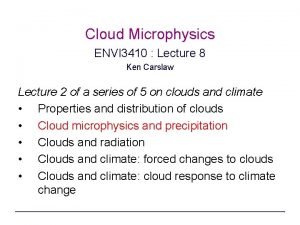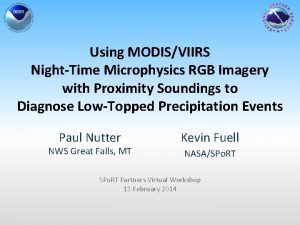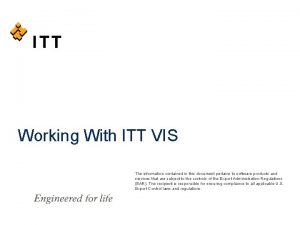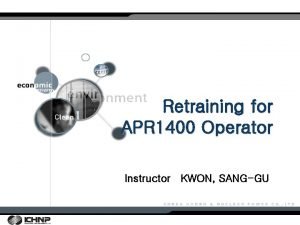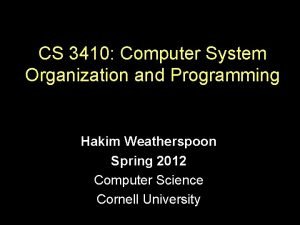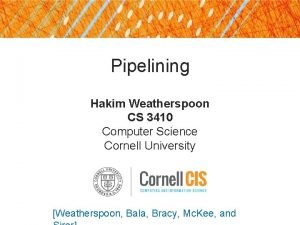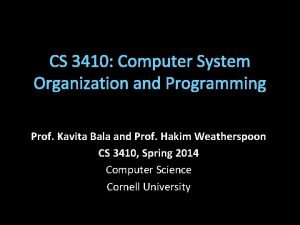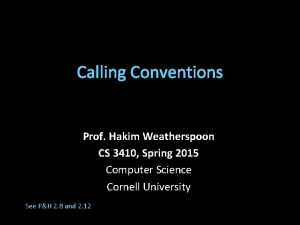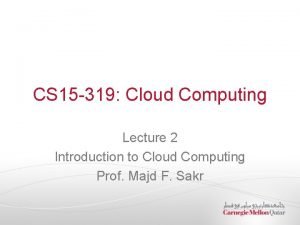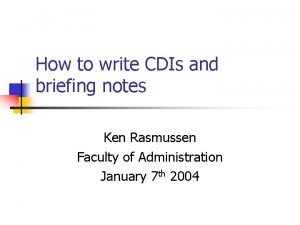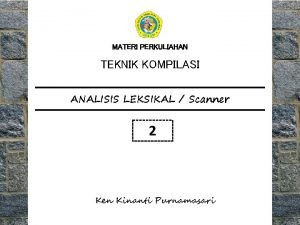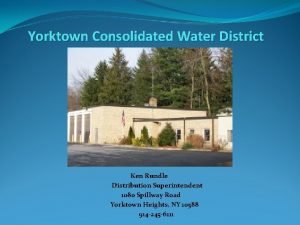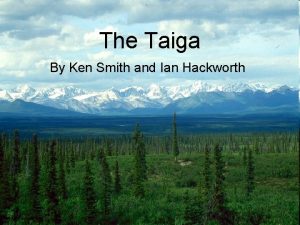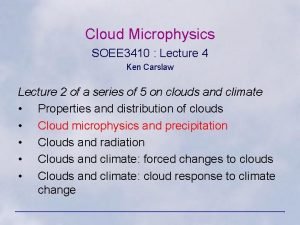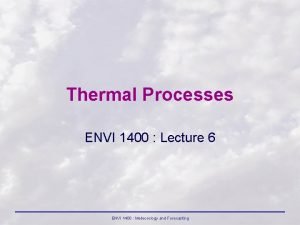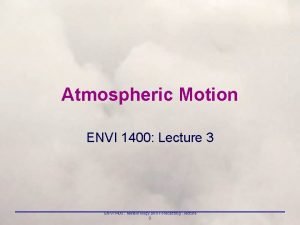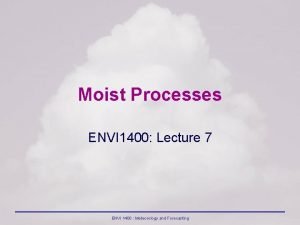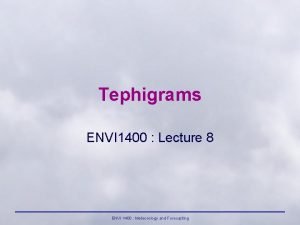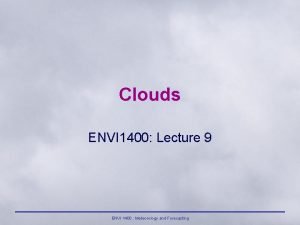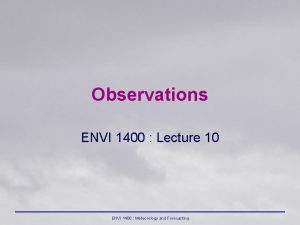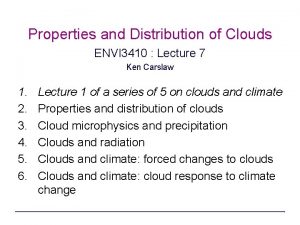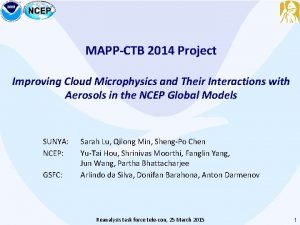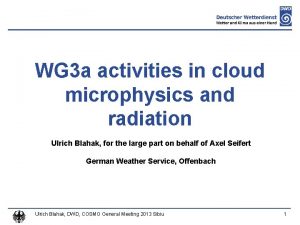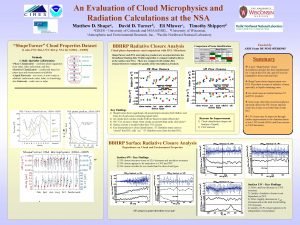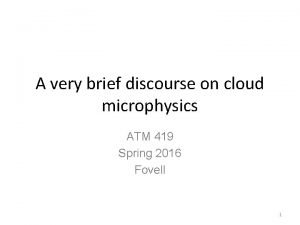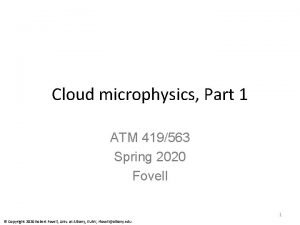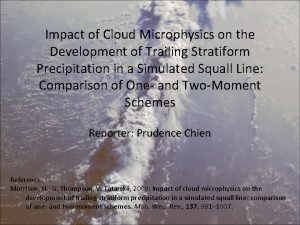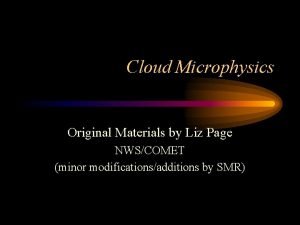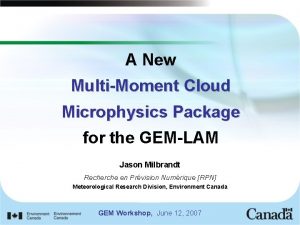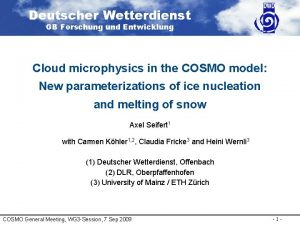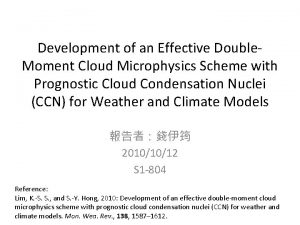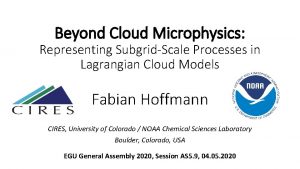Cloud Microphysics ENVI 3410 Lecture 8 Ken Carslaw


























- Slides: 26

Cloud Microphysics ENVI 3410 : Lecture 8 Ken Carslaw Lecture 2 of a series of 5 on clouds and climate • Properties and distribution of clouds • Cloud microphysics and precipitation • Clouds and radiation • Clouds and climate: forced changes to clouds • Clouds and climate: cloud response to climate change

Content of Lecture 8 • Drop formation – factors controlling drop number and size • Rain formation – what is needed? • The ice phase ENVI 3410 : Coupled Ocean & Atmosphere Climate Dynamics 1

Recommended Reading for This Lecture • A Short Course on Cloud Physics, R. R. Rogers and M. K. Yau, 3 rd ed. , Butterworth-Heinemann – Some very readable chapters – Physics L-0 Rog (Reference, short, long) • Several cloud physics books in the library worth flicking through ENVI 3410 : Coupled Ocean & Atmosphere Climate Dynamics 1

What is Cloud Microphysics? • Properties of a cloud on the micro-scale (i. e. , micrometres) • Includes droplet concentrations, sizes, ice crystal formation, droplet-droplet interactions, rain drop formation, etc. ENVI 3410 : Coupled Ocean & Atmosphere Climate Dynamics 1

Microphysics and Climate • Cloud drop number (CDN) influences cloud albedo (next lecture) – Ist indirect effect of aerosols on climate • CDN/size influences precipitation efficiency (and therefore cloud lifetime/distribution and cloud fraction) – 2 nd indirect effect of aerosols on climate • Ice formation affects latent heat release, precipitation intensity, cirrus properties, etc. ENVI 3410 : Coupled Ocean & Atmosphere Climate Dynamics 1

Microphysical Processes • Drop formation – What determines the number and size of drops? • Drop spectrum broadening (collision and coalescence) – How do some drops grow to precipitation-sized particles in the time available? • Ice formation • Ice phase processes (riming, accretion, etc) ENVI 3410 : Coupled Ocean & Atmosphere Climate Dynamics 1

Condensation Nuclei Starting Point for Drop Formation • Droplets form by condensation of water vapour on aerosol particles (condensation nuclei, CN) at very close to 100% RH • Without CN, humidities of >300% are required for drop formation • Droplets form on some (a subset of) CN – Cloud Condensation Nuclei (CCN) • CN are composed of – Salt particles from sea spray – Natural material (inorganic and organic mixtures) – Human pollution (sulphuric acid particles, etc) • ENVI 3410 : Coupled Ocean & Atmosphere Climate Dynamics 1

Cloud Formation Either: • Air rises and cools to saturation (100% RH) and then supersaturation (>100% RH) – Adiabatic expansion • Air cools by radiative energy loss or advection over a cold surface (fogs) ENVI 3410 : Coupled Ocean & Atmosphere Climate Dynamics 1

Increase in humidity in a rising air parcel water pressure 100% RH line Droplets form Air initially at 70% RH Air rises, cools, RH increases 100% RH (saturation, dew point) Droplets grow, remove water vapour temperature ENVI 3410 : Coupled Ocean & Atmosphere Climate Dynamics 1

Droplet “activation” sea salt ammonium sulphate • Small particles require higher humidities because surface tension of small droplets increases the pressure of water vapour over their surface • Consequence: droplets form on large particles first ENVI 3410 : Coupled Ocean & Atmosphere Climate Dynamics 1

Droplet “activation” Typically 1000 -10000 cm-3 Typically 100 -1000 cm-3 growth maximum supersaturation in cloud equates to minimum radius of activation ENVI 3410 : Coupled Ocean & Atmosphere Climate Dynamics 1

Factors affecting droplet number • Aerosol particle size } – larger particles activate at lower humidities • Particle chemical composition – Some substances are more ‘hygroscopic’ Human activities affect these • Aerosol particle number concentration – Simple • Cloud-scale updraught speed – Higher speed = more drops ENVI 3410 : Coupled Ocean & Atmosphere Climate Dynamics 1

Droplet number vs. aerosol size and number • Fixed updraught speed log(N) Solid contours = CDN; colours = aerosol mass (mg m-3) ENVI 3410 : Coupled Ocean & Atmosphere Climate Dynamics Diameter 1

Droplet Evolution Above Cloud Base updraught = 2. 0 ms-1 Height above cloud base (m) updraught = 0. 5 ms-1 80 60 Decreasing supersat’n as 80 droplets grow, suppresses 60 new droplets 80 80 60 60 40 40 20 20 0 0 0. 4 0. 6 Supersaturation (%) 0 200 400 0 2 4 6 Drop conc’n (cm-3) Ave’ radius (mm) (S = %RH-100) ENVI 3410 : Coupled Ocean & Atmosphere Climate Dynamics 0 0. 1 0. 2 Liquid water content (g m-3) 1

Diffusional Droplet Growth (S = %RH-100) Droplets grow by diffusion of water vapour Radius time 1 2. 4 s 2 130 s 4 1000 s 10 2700 s 20 2. 4 hr 30 4. 9 hr 40 12. 4 hr transition drop r=50, V=27 typical drop r=10, V=1 Na. Cl particle (10 -14 g mass); initial radius = 0. 75 micron; RH = 100. 05%; p = 900 mb; T = 273 K large drop r=50, V=27 . typical CN r=0. 1, V=10 -4 typical raindrop: r=1000, V=650 ENVI 3410 : Coupled Ocean & Atmosphere Climate Dynamics 1

Diffusional Droplet Growth • Leads to narrowing of droplet size distribution, but not observed Diffusion only Observed • Possible reasons: Ndrop – Giant CN – Supersaturation fluctuations – Mixing cloud top cloud base Diameter ENVI 3410 : Coupled Ocean & Atmosphere Climate Dynamics cloud base cloud top Diameter 1

Definition of “Precipitation-Sized” Droplet • How big must a droplet be before it can be considered a “raindrop” Initial radius Distance fallen 1 mm 2. 0 mm 3 mm 0. 17 mm 10 mm 2. 1 cm 30 mm 1. 69 m 0. 1 mm 208 m 0. 15 mm 1. 05 km Distance a drop falls before evaporating. Assumes isothermal atmosphere with T=280 K, RH=80% Definition of a drizzle drop ENVI 3410 : Coupled Ocean & Atmosphere Climate Dynamics 1

“Warm Rain” Formation • Rain formation without ice phase • Additional process needed to grow droplets to precipitation size • Collision and coalescence – Two processes: collision rate and coalescence rate Narrow distributions not very efficient for collision Some large drops initiate collisioncoalescence ENVI 3410 : Coupled Ocean & Atmosphere Climate Dynamics 1

Collision and Coalescence Rates “wake” effects Almost all collisions result in coalescence Collision-Coalescence efficiency reduced because small drops are swept round the larger one Coalescence very inefficient below about 20 mm Therefore droplet distribution broadening needed ENVI 3410 : Coupled Ocean & Atmosphere Climate Dynamics 1

Droplet Evolution with Collision. Coalescence 30 25 s) in 20 m e ( 15 tim 10 5 0 10 -3 10 -2 10 -1 100 Radius (cm) 10 mm ENVI 3410 : Coupled Ocean & Atmosphere Climate Dynamics 1

Summary of “Warm Cloud” Microphysics • Precipitation is favoured in clouds with – – Large liquid water content (i. e. , deep cumulus) Broad drop spectrum Large drops (must be larger than ~20 mm) Large vertical extent (=long growth/collision times) ENVI 3410 : Coupled Ocean & Atmosphere Climate Dynamics 1

Precipitation Formation Through Ice Processes Ice forms on ice nuclei (IN) • Silicates (soil dust, etc. ) • Clays • Fungal spores • Combustion particles (soot, etc. ) • Other industrial material ENVI 3410 : Coupled Ocean & Atmosphere Climate Dynamics 1

Ice formation Processes Between – 10 o. C and – 39 o. C Result = very few crystals Contact nucleation freezing Immersion freezing (Rate proportional to drop volume) Deposition nucleation (reverse sublimation) Below – 39 o. C Result = complete freezing of all Homogeneous drops freezing ENVI 3410 : Coupled Ocean & Atmosphere Climate Dynamics 1

The Growth Advantage of Ice Crystals At – 20 o. C at 100% RH Sice = 24% Air is Marginally supersaturated with respect to liquid water in a rising cloud thermal Compare with typical Sliq = 0. 05 -0. 5% ! Highly supersaturated with respect to ice Few crystals grow at expense of drops Subsequent growth from accretion and aggregation ENVI 3410 : Coupled Ocean & Atmosphere Climate Dynamics 1

Atmospheric Ice Nuclei Concentrations ENVI 3410 : Coupled Ocean & Atmosphere Climate Dynamics 1

Effect of Freezing on Cloud Development • Intensification of rain • Release of latent heat aloft (giving further buoyancy) ENVI 3410 : Coupled Ocean & Atmosphere Climate Dynamics 1
 Ken carslaw
Ken carslaw Nighttime microphysics
Nighttime microphysics Envimet
Envimet Itt vis
Itt vis Operator retraining program
Operator retraining program 01:640:244 lecture notes - lecture 15: plat, idah, farad
01:640:244 lecture notes - lecture 15: plat, idah, farad Cs 3410
Cs 3410 Rfc 3410
Rfc 3410 Cs 3410
Cs 3410 Cornell cs 3410
Cornell cs 3410 Cs 3410
Cs 3410 Cs 3410
Cs 3410 Cs 3410
Cs 3410 Cs 3410
Cs 3410 Cloud computing cmu
Cloud computing cmu Parallel and distributed computing lecture notes
Parallel and distributed computing lecture notes Snap cloud
Snap cloud Cloud computing refers to
Cloud computing refers to Cloud integration patterns
Cloud integration patterns Public cloud vs private cloud cost analysis
Public cloud vs private cloud cost analysis Ken lulay
Ken lulay Ken brady
Ken brady Analisis leksikal
Analisis leksikal Ken lackman
Ken lackman Water main break yorktown heights ny
Water main break yorktown heights ny Dr ken matto
Dr ken matto Ken taiga
Ken taiga
